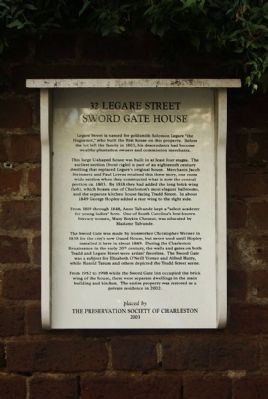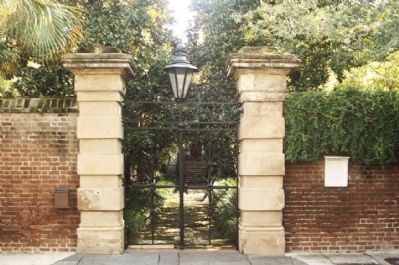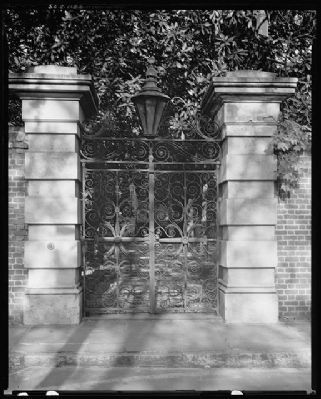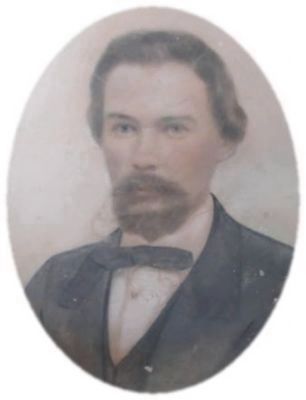South of Broad in Charleston in Charleston County, South Carolina — The American South (South Atlantic)
32 Legare Street
Sword Gate House
This large U-shaped house was built in at least four stages. The earliest section (front right) is part of the eighteenth century dwelling that replaced Legare’s original house. Merchants Jacob Steinmetz and Paul Lorent retained this three story, one room wide section when they constructed what is now the central portion ca. 1803. By 1818 they had added long brick wing (left), which boasts one of Charleston’s most elegant ballrooms, and the separate kitchen house facing Tradd Street. In about 1849 George Hopley added a rear wing to the right side.
From 1819 through 1848, Anne Talvande kept a “select academy for young ladies” here. One of South Carolina’s best-known literary women, Mary Boykin Chesnut, was educated by Madame Talvande.
The Sword Gate was made by ironworker Christopher Werner in 1838 for the city’s new Guard House, but never used until Hopley installed it here in about 1849. During the Charleston Renaissance in the early 20th century, the walls and gates on both Tradd and Legare Street were artists’ favorites. The Sword Gate was a subject for Elizabeth O’Neill Verner and Alfred Hutty, while Harold Tatum and others depicted the Tradd Street scene.
From 1952 to 1998 while the Sword Gate Inn occupied the brick wing of the house, there were separate dwellings in the main building and kitchen. The entire property was restored as a private residence in 2002.
Erected 2003 by Preservation Society of Charleston.
Topics and series. This historical marker is listed in this topic list: Notable Buildings. In addition, it is included in the South Carolina, Preservation Society of Charleston series list. A significant historical year for this entry is 1803.
Location. 32° 46.438′ N, 79° 56.05′ W. Marker is in Charleston, South Carolina, in Charleston County. It is in South of Broad. Marker is on Legare Street, on the left when traveling south. Touch for map. Marker is at or near this postal address: 32 Legare Street, Charleston SC 29401, United States of America. Touch for directions.
Other nearby markers. At least 10 other markers are within walking distance of this marker. 123 Tradd Street (within shouting distance of this marker); 125 Tradd Street (within shouting distance of this marker); The Reverend Paul Trapier Gervais House (within shouting distance of this marker); 126 Tradd Street (about 300 feet away, measured in a direct line); Colonel John Stuart House (about 300 feet away); Simmons-Edwards House (about 500 feet away); Toomer- Purse House (about 500 feet away); St. Peter's Episcopal Church Cemetery (about 500 feet away); 95 Lenwood Boulevard (about 500 feet away); John Fullerton House (about 500 feet away). Touch for a list and map of all markers in Charleston.
Regarding 32 Legare Street. The block south of Tradd Street has some of Charleston’s most famous gates, interesting houses, memorable gardens, and at least three locations that once served as female academies. Legare, pronounced Lugree, is home to the fabled Sword Gate at number 32 and the eye-catching Pineapple Gate at number 14, both of which involve some artist error. The Sword Gate design was fashioned for the city Guard House in 1830 by noted Charleston iron smith Christopher Werner, who mistakenly thought the order called for two copies. This gate is the copy, purchased and installed at 32 Legare in 1849.
Also see . . . Christopher Werner. Christopher W. Werner (1805–1875) was a well known nineteenth-century wrought iron manufacturer, artisan and
entrepreneur from the state of South Carolina. (Submitted on June 23, 2012, by Brian Scott of Anderson, South Carolina.)
Additional commentary.
1. Solomon Legare, the Huguenot
The father of that Solomon Legare the Huguenot, from whom the Legares of South Carolina are descended, never left France, never came to America, and never was a Huguenot by profession, though he was utterly opposed to the persecution of Bible Christians. He continued nominally a member of the Church of Rome to the day of his death, which occurred suddenly while he was living with his wife, Madame Legare, in their own home on the banks of the Loire, in France. He left four sons — the three oldest sons were by his first wife, and all of them were members of the Church of Koine. These three sons emigrated from France to the French Province of Canada, in company with Monsieur Valier, second Bishop of Quebec, about the year 1686. Their descendants are still in Canada, and are all still Romanists.
His fourth, and youngest son Solomon Legare, was the only child of his second wife, Madame Legare, who was a Huguenot, and a descendant, through many generations, of the Waldenses. This son, Solomon, was educated by his mother in the Protestant faith of the Huguenots; and before he was twenty years of age, became an object of Papal hatred and persecution. This was that Soloman Legare, the Huguenot, who became the ancestor of the Legare Family of South Carolina. He fled from Papal persecution in France, in 1685, some months before the revocation of the Edict of Nantes, while he was at college in the city of Lyons, and while both of his parents were living in their own home on the banks of the river Loire, not far from the city of Lyons.
The sudden death of her husband left Madame Legare without a protector; the estate was immediately seized by Roman Catholic members of the family, and the daily increasing horrors of the persecution raging all around, warned her to escape quickly, which she did under cover of a visit to her own relatives, who lived on the shore of the Mediterranean Sea. From thence, she escaped along with them to the shelter of an English ship, just a few days before the revocation of the Edict of Nantes was signed. In this way Madame Legare reached Bristol, in England, where she met her son by appointment.
They remained some months in Bristol, and while living there, Solomon Legare, the Huguenot, married a young English lady of eminent piety. Not long after their marriage, he, in company with his young bride and his mother. Madame Legare, sailed for the British Province of Carolina, in America. They readied Charles Town, in South Carolina, late in the year 1786, where Mr. Solomon Legare soon after became, along with other Huguenots and Congregationalists from England, one of the founders of the old Congregational (Circular) Church, in Charleston, and he continued, for many years to be one of its most prominent church officers. His mother, Madame Legare, was the first adult person buried in that church-yard. Her mortal remains lie under the circular foundation of the second building erected upon that site, which was much larger than the first building was. (Source: Biographical Sketches of the Huguenot Solomon Legare, and of His Family.)
— Submitted June 23, 2012, by Brian Scott of Anderson, South Carolina.
Credits. This page was last revised on February 16, 2023. It was originally submitted on October 1, 2011, by Mike Stroud of Bluffton, South Carolina. This page has been viewed 2,318 times since then and 72 times this year. Photos: 1, 2. submitted on October 1, 2011, by Mike Stroud of Bluffton, South Carolina. 3. submitted on January 2, 2012, by Mike Stroud of Bluffton, South Carolina. 4. submitted on June 23, 2012, by Brian Scott of Anderson, South Carolina.



